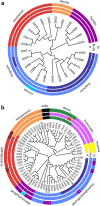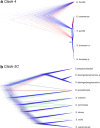A next generation approach to species delimitation reveals the role of hybridization in a cryptic species complex of corals
- PMID: 31170912
- PMCID: PMC6555025
- DOI: 10.1186/s12862-019-1427-y
A next generation approach to species delimitation reveals the role of hybridization in a cryptic species complex of corals
Abstract
Background: Our ability to investigate processes shaping the evolutionary diversification of corals (Cnidaria: Anthozoa) is limited by a lack of understanding of species boundaries. Discerning species of corals has been challenging due to a multitude of factors, including homoplasious and plastic morphological characters and the use of molecular markers that are either not informative or have not completely sorted. Hybridization can also blur species boundaries by leading to incongruence between morphology and genetics. We used traditional DNA barcoding and restriction-site associated DNA sequencing combined with coalescence-based and allele-frequency methods to elucidate species boundaries and simultaneously examine the potential role of hybridization in a speciose genus of octocoral, Sinularia.
Results: Species delimitations using two widely used DNA barcode markers, mtMutS and 28S rDNA, were incongruent with one another and with the morphospecies identifications. When mtMutS and 28S were concatenated, a 0.3% genetic distance threshold delimited the majority of morphospecies. In contrast, 12 of the 15 examined morphospecies formed well-supported monophyletic clades in both concatenated RAxML phylogenies and SNAPP species trees of > 6000 RADSeq loci. DAPC and Structure analyses also supported morphospecies assignments, but indicated the potential for two additional cryptic species. Three morphologically distinct species pairs could not, however, be distinguished genetically. ABBA-BABA tests demonstrated significant admixture between some of those species, suggesting that hybridization may confound species delimitation in Sinularia.
Conclusions: A genomic approach can help to guide species delimitation while simultaneously elucidating the processes generating coral diversity. Results support the hypothesis that hybridization is an important mechanism in the evolution of Anthozoa, including octocorals, and future research should examine the contribution of this mechanism in generating diversity across the coral tree of life.
Keywords: Anthozoa; Coral reefs; Hybridization; Octocorallia; Phylogenetics; RADSeq; Taxonomy.
Conflict of interest statement
The authors declare that they have no competing interests.
Figures







Similar articles
-
New approaches to species delimitation and population structure of anthozoans: Two case studies of octocorals using ultraconserved elements and exons.Mol Ecol Resour. 2021 Jan;21(1):78-92. doi: 10.1111/1755-0998.13241. Epub 2020 Sep 18. Mol Ecol Resour. 2021. PMID: 32786110
-
Species boundaries in the absence of morphological, ecological or geographical differentiation in the Red Sea octocoral genus Ovabunda (Alcyonacea: Xeniidae).Mol Phylogenet Evol. 2017 Jul;112:174-184. doi: 10.1016/j.ympev.2017.04.025. Epub 2017 Apr 30. Mol Phylogenet Evol. 2017. PMID: 28467886
-
Molecular evolution of calcification genes in morphologically similar but phylogenetically unrelated scleractinian corals.Mol Phylogenet Evol. 2014 Aug;77:281-95. doi: 10.1016/j.ympev.2014.04.015. Epub 2014 Apr 26. Mol Phylogenet Evol. 2014. PMID: 24780747
-
Molecular phylogenetic insights into the evolution of Octocorallia: a review.Integr Comp Biol. 2010 Sep;50(3):389-410. doi: 10.1093/icb/icq056. Epub 2010 May 24. Integr Comp Biol. 2010. PMID: 21558211 Review.
-
Rethinking the phylogeny of scleractinian corals: a review of morphological and molecular data.Integr Comp Biol. 2010 Sep;50(3):411-27. doi: 10.1093/icb/icq062. Epub 2010 Jun 3. Integr Comp Biol. 2010. PMID: 21558212 Review.
Cited by
-
Not out of the Mediterranean: Atlantic populations of the gorgonian Paramuricea clavata are a separate sister species under further lineage diversification.Ecol Evol. 2023 Jan 29;13(1):e9740. doi: 10.1002/ece3.9740. eCollection 2023 Jan. Ecol Evol. 2023. PMID: 36789139 Free PMC article.
-
Updated Trends on the Biodiscovery of New Marine Natural Products from Invertebrates.Mar Drugs. 2022 Jun 9;20(6):389. doi: 10.3390/md20060389. Mar Drugs. 2022. PMID: 35736192 Free PMC article. Review.
-
Biodiversity and biogeography of zooxanthellate soft corals across the Indo-Pacific.Sci Rep. 2025 May 2;15(1):15461. doi: 10.1038/s41598-025-98790-7. Sci Rep. 2025. PMID: 40316679 Free PMC article.
-
Integrating cryptic diversity into coral evolution, symbiosis and conservation.Nat Ecol Evol. 2024 Apr;8(4):622-636. doi: 10.1038/s41559-023-02319-y. Epub 2024 Feb 13. Nat Ecol Evol. 2024. PMID: 38351091 Review.
-
Skimming genomes for systematics and DNA barcodes of corals.Ecol Evol. 2024 May 13;14(5):e11254. doi: 10.1002/ece3.11254. eCollection 2024 May. Ecol Evol. 2024. PMID: 38746545 Free PMC article.
References
-
- Babcock RC, Bull GD, Harrison PD, Heyward AJ, Oliver JK, Wallace CC, Willis BL. Synchronous spawnings of 105 scleractinian coral species on the great barrier reef. Mar Biol. 1986;90:379–394. doi: 10.1007/BF00428562. - DOI
-
- Benayahu Y, Loya Y. Space partitioning by stony corals, soft corals and benthic algae on the coral reefs of the northern Gulf of Eilat (Red Sea) Helgoländer Meeresun. 1977;30:362–382. doi: 10.1007/BF02207848. - DOI
-
- Benayahu Y. Species composition of soft corals (Octocorallia, Alcyonacea) on the coral reefs of Sesoko Island, Ryukyu archipelago, Japan. Galaxea. 1995;12:103–124.
Publication types
MeSH terms
Grants and funding
LinkOut - more resources
Full Text Sources

